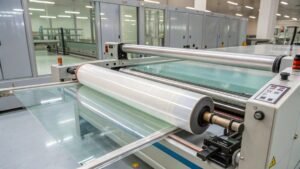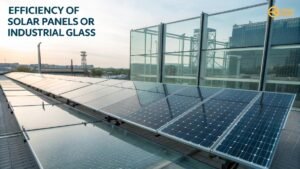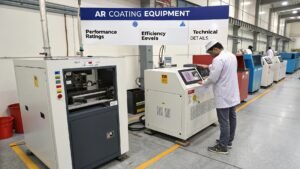Anti-glare etched glass is revolutionizing industries that require clear visibility and reduced reflections. Whether used in architectural applications, display screens, or solar panels, this advanced glass solution enhances clarity while minimizing glare.
Anti-glare etched glass is treated to diffuse reflected light, reducing glare and improving visibility. The etching process creates a fine texture on the glass surface, scattering incoming light instead of reflecting it directly. This technology is widely used in display protection, architectural glass, and solar panel efficiency.

By understanding its functionality and applications, businesses can maximize its benefits. Let’s explore how it works and why it’s essential for various industries.
How is anti-glare etched glass made?
Glare can make screens unreadable and disrupt interior lighting. This is where anti-glare etched glass comes in, improving both functionality and aesthetics.
Anti-glare etched glass is produced through a controlled acid-etching or sandblasting process that creates microscopic textures on the surface. These textures scatter light, reducing direct reflections and increasing visibility.
The Etching Process
- Acid Etching – Hydrofluoric acid is used to corrode the glass surface in a controlled manner, creating micro-level patterns.
- Sandblasting – High-pressure abrasive particles blast the glass, roughening the surface to diffuse light.
- Nano-Coating Applications – Additional nano-coatings may be applied to enhance durability, scratch resistance, or hydrophobic properties.
| Etching Method | Process Description | Application |
|---|---|---|
| Acid Etching | Chemical corrosion creates fine textures | High-end architectural and display glass |
| Sandblasting | Mechanical abrasion produces rough surfaces | Industrial and commercial glass panels |
| Nano-Coating | Protective layer enhances performance | Solar and high-tech applications |
These treatments ensure that anti-glare glass maintains optimal transparency while reducing reflection.
What are the benefits of anti-glare etched glass?
In high-light environments, reflections can obstruct visibility and strain the eyes. Anti-glare etched glass solves this issue, making it indispensable for multiple industries.
The main benefits of anti-glare etched glass include reduced eye strain, improved screen readability, enhanced aesthetics, and better efficiency in solar panels.
Key Advantages:
- Reduced Reflections – Minimizes glare from sunlight or artificial lighting.
- Enhanced Visibility – Ideal for display screens, information boards, and glass facades.
- Increased Durability – Resistant to fingerprints and scratches.
- Better Solar Efficiency – Reduces energy loss due to excessive reflection.
Industries like architecture, electronics, and solar energy benefit greatly from these properties.
Where is anti-glare etched glass used?
From skyscraper windows to high-resolution display screens, anti-glare etched glass is a versatile solution.
It is commonly used in architectural glass, touchscreen displays, automotive windshields, and photovoltaic solar panels.
Industry-Specific Applications
1. Architectural Glass
- Used in office buildings, museums, and commercial spaces.
- Enhances indoor lighting comfort by reducing glare.
2. Display and Touchscreen Protection
- Improves readability on smartphones, tablets, and monitors.
- Reduces fingerprint smudging and reflections.
3. Automotive Windshields
- Enhances driver visibility in bright conditions.
- Prevents reflections that could obstruct vision.
4. Solar Panel Technology
- Used in Perovskite Coating for Solar Panels and Thin Film CdTe PV Technology
- Minimizes light reflection to maximize energy absorption.
How does anti-glare glass improve solar panel efficiency?
Energy efficiency is a critical factor in solar technology. Any reflection loss in solar panels reduces overall power generation.
Anti-glare etched glass improves solar panel performance by reducing light reflection and increasing energy absorption. This allows more sunlight to reach photovoltaic cells, boosting efficiency.
Solar Efficiency Enhancement
- Lower Reflection Loss – More light reaches the photovoltaic cells.
- Durability – Resistant to environmental degradation.
- Improved Performance in Low-Light Conditions – Better light absorption during cloudy weather.
At Glass Coat, we specialize in Anti-Reflective Coating for Photovoltaic Glass, ensuring maximum energy yield for solar manufacturers.
How does anti-glare glass compare to other glass treatments?
Different glass treatments exist to manage light diffusion and reflection. Here’s how anti-glare etched glass compares to other options.
| Feature | Anti-Glare Etched Glass | Anti-Reflective Coating | Standard Glass |
|---|---|---|---|
| Light Diffusion | High | Medium | Low |
| Glare Reduction | Excellent | Moderate | Poor |
| Durability | High | Requires maintenance | Standard |
| Cost | Moderate | High | Low |
While anti-reflective coatings improve clarity, they require periodic maintenance. Anti-glare etched glass provides a balance between durability, performance, and cost-efficiency.
Conclusion
Anti-glare etched glass enhances visibility and reduces reflections, making it essential for architectural, display, and solar applications. By optimizing light diffusion, it improves efficiency and durability across industries.





